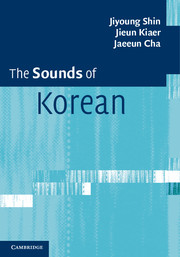Book contents
- Frontmatter
- Contents
- Figures
- Tables
- Preface
- Notational conventions
- 1 Characteristics of the Korean language
- 2 Production of sounds
- 3 Basic concepts of phonology
- 4 Consonants
- 5 Vowels
- 6 Frequency trends of Korean sounds
- 7 Prosody
- 8 Phonological rules of Korean (I)
- 9 Phonological rules of Korean (II)
- 10 Loanword phonology
- Notes
- Bibliography
- Index
5 - Vowels
Published online by Cambridge University Press: 05 November 2012
- Frontmatter
- Contents
- Figures
- Tables
- Preface
- Notational conventions
- 1 Characteristics of the Korean language
- 2 Production of sounds
- 3 Basic concepts of phonology
- 4 Consonants
- 5 Vowels
- 6 Frequency trends of Korean sounds
- 7 Prosody
- 8 Phonological rules of Korean (I)
- 9 Phonological rules of Korean (II)
- 10 Loanword phonology
- Notes
- Bibliography
- Index
Summary
In the previous chapter, we discussed consonants in Korean. In this chapter, we will discuss vowels in Korean. In particular, we will explore which vowels are phonemes in Korean and what their phonetic and phonological characteristics are. In 5.1, we will introduce the basic properties of vowels. In 5.2 and 5.3, we will examine in detail the phonetic and phonological characteristics of monophthongs (simple vowels) and diphthongs in Korean and 5.4 covers features for vowels. The chapter summary can be found in 5.5.
Monophthongs and diphthongs
A monophthong (or simple vowel) is a vowel consisting of one articulation from beginning to end. Likewise, a diphthong is a vowel made up of two articulations and a triphthong is a vowel made up of three articulations. Diphthongs can be further analysed into their constituent parts, glides and monophthongs. The articulation of a glide is similar to that of a vowel, but as it is pronounced much faster it does not remain stable during articulation, unlike vowels. Moreover, unlike a vowel, a glide cannot form a syllable by itself.
- Type
- Chapter
- Information
- The Sounds of Korean , pp. 95 - 117Publisher: Cambridge University PressPrint publication year: 2012



